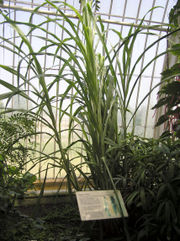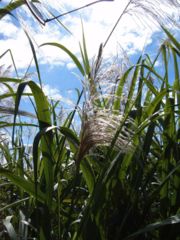Sugarcane
2007 Schools Wikipedia Selection. Related subjects: Food and agriculture; Plants
| iSugarcane | ||||||||||||
|---|---|---|---|---|---|---|---|---|---|---|---|---|
 Sugarcane leaves
|
||||||||||||
| Scientific classification | ||||||||||||
|
||||||||||||
|
|
||||||||||||
|
Saccharum arundinaceum |
Sugarcane or Sugar cane (Saccharum) is a genus of 6 to 37 species (depending on taxonomic interpretation) of tall grasses (family Poaceae, tribe Andropogoneae), native to warm temperate to tropical regions of the Old World. They have stout, jointed, fibrous stalks that are rich in sugar and measure 2 to 6 meters tall. All of the sugarcane species interbreed, and the major commercial cultivars are complex hybrids.
Cultivation and uses
About 200 countries grow the crop to produce 1,324 million tons (more than six times the amount of sugar beet produced). As of the year 2005, the world's largest producer of sugar cane by far is Brazil. Uses of sugar cane include the production of sugar, Falernum, molasses, rum, and ethanol for fuel.
History
Sugarcane is a grass originally from tropical Southeast Asia (Hortus Third). The thick stalk stores energy as sucrose in the sap. From this juice, sugar is extracted by evaporating the water. Crystallized sugar was reported 2500 years ago in India. Around the eighth century A.D., Arabs introduced sugar to the Mediterranean and it was cultivated in Spain. It was among the early crops brought to the Americas by Spaniards.
Sugarcane was grown extensively in the Caribbean, and still is on some islands. In colonial times, sugar was a major product of the triangular trade of New World raw materials, European manufactures, and African slaves. France found its sugarcane islands so valuable it effectively traded Canada to Britain for their return of Guadeloupe, Martinique and St. Lucia at the end of the Seven Years' War. The Dutch similarly kept Suriname, a sugar colony in South America, instead of seeking the return of the New Netherlands (New Amsterdam). Cuban sugarcane produced sugar that received price supports from and a guaranteed market in the USSR; the dissolution of that country forced the closure of most of Cuba's sugar industry. Sugarcane remains an important part of the economy of Barbados, the Dominican Republic, Guadeloupe, Jamaica, Grenada, and other islands. The sugarcane industry is a major export for the Caribbean, but it is expected to collapse with the removal of European preferences by 2009.
Sugarcane production greatly influenced many tropical Pacific islands, most particularly Hawaii and Fiji. In these islands, sugar came to dominate the economic and political landscape after the indigenous societies had been invaded by Europeans and Americans, who promoted immigration from various Asian countries for workers to tend and harvest the crop. Sugar-industry policies eventually established the ethnic makeup of the island populations that now exist, profoundly affecting modern politics and society in the islands.
Brazil is a major grower of sugarcane, which is used to produce sugar and provide the alcohol used in making gasohol and biodiesel fuels.
Cultivation
Sugarcane cultivation requires a tropical or subtropical climate, with a minimum of 600 mm (24 in) of annual moisture. It is one of the most efficient photosynthesizers in the plant kingdom, able to convert up to 2 percent of incident solar energy into biomass. In prime growing regions, such as Hawaii, sugarcane can produce 20 kg for each square meter exposed to the sun.
Sugarcane is propagated from cuttings, rather than from seeds; although certain types still produce seeds, modern methods of stem cuttings have become the most common method of reproduction. Each cutting must contain at least one bud, and the cuttings are usually planted by hand. Once planted, a stand of cane can be harvested several times; after each harvest, the cane sends up new stalks, called ratoons. Usually, each successive harvest gives a smaller yield, and eventually the declining yields justify replanting. Depending on agricultural practice, two to ten harvests may be possible between plantings.

Sugarcane is used as a food plant by the larvae of some lepidoptera species, including turnip moth.
Sugarcane is harvested by hand or mechanically. Hand harvesting accounts for more than half of the world's production, and is especially dominant in the developing world. When harvested by hand, the field is first set on fire. The fire spreads rapidly, burning away dry dead leaves, and killing any venomous snakes hiding in the crop, but leaving the water-rich stalks and roots unharmed. With knives(usually Cane Knives, but Machetes are also commonly used), harvesters then cut the standing cane just above the ground. A skilled harvester can cut 500 kg of sugarcane in an hour.
The sugarcane combine, or chopper harvester, is a harvesting machine originally developed in Australia. It cuts the cane at the base of the stalk, separates the cane from its leaves, and deposits the cane into a cart while blowing the cut leaves back onto the field. Such machines can harvest 30 tonnes of cane each hour, but cane harvested using these machines must be transported to the processing plant rapidly; once cut, sugarcane begins to lose its sugar content, and damage inflicted on the cane during mechanical harvesting accelerates this decay.
Processing
Traditionally, sugarcane has been processed in two stages. Sugarcane mills, located in sugarcane-producing regions, extract sugar from freshly harvested sugarcane, resulting in raw sugar for later refining, and in "mill white" sugar for local consumption. Sugar refineries, often located in heavy sugar-consuming regions, such as North America, Europe, and Japan, then purify raw sugar to produce refined white sugar, a product that is more than 99 percent pure sucrose. These two stages are slowly becoming blurred. Increasing affluence in the sugar-producing tropics has led to an increase in demand for refined sugar products in those areas, where a trend toward combined milling and refining has developed.
Milling
In a sugar mill, sugarcane is washed, chopped, and shredded by revolving knives. The shredded cane is repeatedly mixed with water and crushed between rollers; the collected juices (called garapa in Brazil) contain 10–15 percent sucrose, and the remaining fibrous solids, called bagasse, are burned for fuel. Bagasse makes a sugar mill more than self-sufficient in energy; the surplus bagasse can be used for animal feed, in paper manufacture, or burned to generate electricity for the local power grid.
The cane juice is next mixed with lime to adjust its pH to 7. This mixing arrests sucrose's decay into glucose and fructose, and precipitates out some impurities. The mixture then sits, allowing the lime and other suspended solids to settle out, and the clarified juice is concentrated in a multiple-effect evaporator to make a syrup about 60 percent by weight in sucrose. This syrup is further concentrated under vacuum until it becomes supersaturated, and then seeded with crystalline sugar. Upon cooling, sugar crystallizes out of the syrup. A centrifuge is used to separate the sugar from the remaining liquid, or molasses. Additional crystallizations may be performed to extract more sugar from the molasses; the molasses remaining after no more sugar can be extracted from it in a cost-effective fashion is called blackstrap.
Raw sugar has a yellow to brown colour. If a white product is desired, sulfur dioxide may be bubbled through the cane juice before evaporation; this chemical bleaches many colour-forming impurities into colourless ones. Sugar bleached white by this sulfitation process is called "mill white," "plantation white," and "crystal sugar." This form of sugar is the form most commonly consumed in sugarcane-producing countries.
Refining
In sugar refining, raw sugar is further purified. It is first mixed with heavy syrup and then centrifuged clean. This process is called "affination"; its purpose is to wash away the outer coating of the raw sugar crystals, which is less pure than the crystal interior. The remaining sugar is then dissolved to make a syrup, about 70 percent by weight solids.
The sugar solution is clarified by the addition of phosphoric acid and calcium hydroxide, which combine to precipitate calcium phosphate. The calcium phosphate particles entrap some impurities and absorb others, and then float to the top of the tank, where they can be skimmed off. An alternative to this "phosphatation" technique is " carbonatation," which is similar, but uses carbon dioxide and calcium hydroxide to produce a calcium carbonate precipitate.
After any remaining solids are filtered out, the clarified syrup is decolorized by filtration through a bed of activated carbon; bone char was traditionally used in this role, but its use is no longer common. Some remaining colour-forming impurities adsorb to the carbon bed. The purified syrup is then concentrated to supersaturation and repeatedly crystallized under vacuum, to produce white refined sugar. As in a sugar mill, the sugar crystals are separated from the molasses by centrifugation. Additional sugar is recovered by blending the remaining syrup with the washings from affination and again crystallizing to produce brown sugar. When no more sugar can be economically recovered, the final molasses still contains 20–30 percent sucrose and 15–25 percent glucose and fructose.
To produce granulated sugar, in which the individual sugar grains do not clump together, sugar must be dried. Drying is accomplished first by drying the sugar in a hot rotary dryer, and then by conditioning the sugar by blowing cool air through it for several days.
Ribbon cane syrup
Ribbon cane is a subtropical type that was once widely grown in southern United States, as far north as coastal North Carolina. The juice was extracted with horse or mule-powered crushers; the juice was boiled, like maple syrup, in a flat pan, and then used in the syrup form as a sweetener for other foods. It is not a commercial crop nowadays, but a few growers try to keep alive the old traditions and find ready sales for their product. Most sugarcane production in the United States occurs in Florida and Louisiana, and to a lesser extent in Hawaii and Texas.
Sugarcane as foodstuff

In most countries where sugarcane is cultivated, there are several foodstuffs and popular dishes derived from it, such as:
- Direct consumption of raw sugarcane cylinders or cubes, which are chewed to extract the juice, and the bagasse is spat out
- Freshly extracted juice ( garapa, guarab, guarapa, guarapo, papelón, or caldo de cana) by hand or electrically operated small mills, with a touch of lemon and ice, makes a delicious and popular drink.
- Molasses, used as a sweetener and as a syrup accompanying other foods, such as cheese or cookies
- Rapadura, a candy made of flavored solid brown sugar in Brazil, which can be consumed in small hard blocks, or in pulverized form (flour), as an add-on to other desserts.
- Sugarcane is also used in rum production, especially in the Caribbean.






